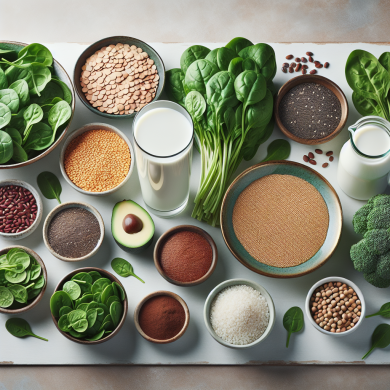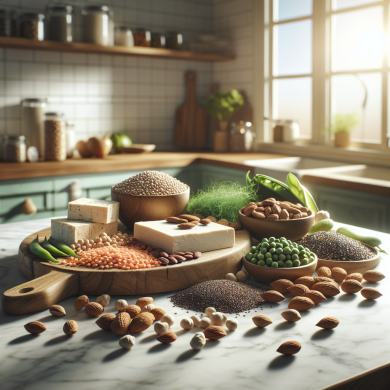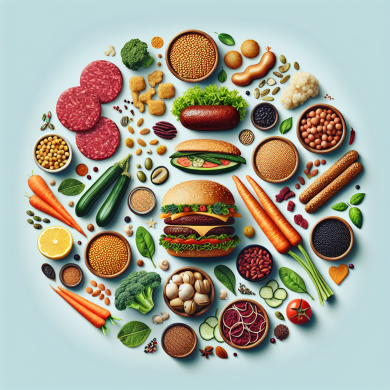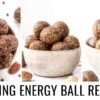Boost Health with Plant-Based Iron Power Foods
Introduction to Iron and Its Importance
Iron is a critical mineral that plays an essential role in numerous bodily functions, including the production of hemoglobin, which is responsible for transporting oxygen in the blood. A deficiency in iron can lead to anemia, a condition characterized by fatigue and weakness. While many associate iron with red meat, plant-based sources can also be excellent providers of this vital nutrient. Embracing plant-based iron sources not only supports a balanced diet but also contributes to overall health and well-being.
Understanding Plant-Based Iron
Iron can be found in two forms: heme and non-heme. Heme iron is found in animal products and is more readily absorbed by the body. Non-heme iron, however, is found in plant-based foods. Although non-heme iron is absorbed less efficiently, it can still meet your daily iron needs with proper dietary planning.
The Role of Vitamin C in Iron Absorption
One of the keys to maximizing the absorption of non-heme iron is pairing it with vitamin C-rich foods. Vitamin C acts as a potent enhancer, converting iron into a form that is more easily absorbed by the body. Incorporating foods high in vitamin C into meals can significantly improve iron uptake and increase its bioavailability.
Top Plant-Based Iron Power Foods
1. Lentils
Lentils are a powerhouse of nutrients, providing a substantial amount of iron. One cup of cooked lentils contains about 6.6 mg of iron, which is over a third of the recommended daily intake for men and nearly half for women. Additionally, lentils are rich in protein and fiber, making them a versatile and nutritious addition to any diet.
2. Spinach
Spinach is renowned for its high iron content, with one cup of cooked spinach offering approximately 6.4 mg of iron. It is also packed with antioxidants, vitamins, and minerals, making it a fantastic choice for overall health. To enhance iron absorption, consider pairing spinach with a source of vitamin C, such as a squeeze of lemon juice.
3. Quinoa
Quinoa is not only a complete protein source but also a great provider of iron. One cup of cooked quinoa contains around 2.8 mg of iron. This gluten-free grain is also rich in other essential nutrients, making it a staple for those following plant-based diets.
4. Pumpkin Seeds
Pumpkin seeds are a convenient and tasty way to boost your iron intake, offering about 2.5 mg of iron per ounce. They are also a good source of magnesium, zinc, and omega-3 fatty acids. Enjoy pumpkin seeds as a snack or add them to salads, smoothies, or baked goods for an extra nutritional punch.
5. Tofu
Tofu is a versatile and protein-rich food that provides an excellent source of iron, with half a cup containing approximately 3.4 mg. It can be used in various dishes, from stir-fries to soups, and easily absorbs the flavors of the ingredients it is cooked with.
6. Black Beans
Black beans are not only high in protein and fiber but also a significant source of iron, with one cup providing about 3.6 mg. They are a staple in many cuisines and can be incorporated into a variety of dishes, from chili to salads.
7. Chickpeas
Chickpeas, or garbanzo beans, are another excellent source of plant-based iron, providing about 4.7 mg per cup. They are incredibly versatile and can be used in dishes ranging from hummus to stews and salads.
Enhancing Iron Absorption
While consuming iron-rich foods is essential, there are several strategies to enhance the absorption of non-heme iron:
1. Pairing with Vitamin C-Rich Foods
As mentioned earlier, vitamin C can significantly boost iron absorption. Incorporate foods like citrus fruits, tomatoes, bell peppers, and broccoli into your meals to enhance the bioavailability of iron.
2. Avoiding Iron Inhibitors
Some compounds can inhibit the absorption of non-heme iron. These include phytates (found in grains and legumes), calcium, and tannins (present in tea and coffee). While these foods are nutritious, it’s advisable to consume them in moderation and not alongside iron-rich meals.
3. Cooking Methods
Certain cooking methods can increase the availability of iron in foods. For instance, soaking and sprouting legumes and grains can reduce phytate levels, enhancing iron absorption. Similarly, cooking foods in cast iron cookware can increase their iron content.
Incorporating Plant-Based Iron into Your Diet
Transitioning to a plant-based diet rich in iron is easier than it may seem. Here are some practical tips to help you integrate these foods into your daily meals:
1. Meal Planning
Plan your meals to include a variety of iron-rich foods throughout the week. This ensures a balanced intake of nutrients and helps prevent deficiencies.
2. Experiment with Recipes
Explore new recipes that incorporate plant-based iron sources. Try making lentil soups, quinoa salads, tofu stir-fries, or chickpea curries to add diversity to your diet.
3. Snack Smart
Choose iron-rich snacks like roasted pumpkin seeds, hummus with vegetables, or a handful of nuts and dried fruits to keep your energy levels up and support your iron intake.
Conclusion
Embracing plant-based iron power foods not only supports a sustainable and ethical diet but also offers numerous health benefits. By incorporating a variety of iron-rich plant foods and enhancing their absorption through dietary strategies, you can ensure adequate iron intake and promote overall well-being. Remember that a balanced diet, rich in diverse nutrients and paired with mindful eating habits, is key to optimizing your health. Whether you are already following a plant-based lifestyle or just starting to explore it, there are plenty of delicious and nutritious options to boost your iron intake and support your body’s needs.















Add comment